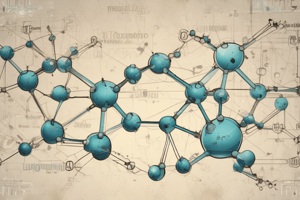Podcast
Questions and Answers
What aspect of inorganic chemistry focuses on the analysis of the arrangement and spatial relationships of atoms within solids?
What aspect of inorganic chemistry focuses on the analysis of the arrangement and spatial relationships of atoms within solids?
- Transition metals bonding
- Coordination chemistry
- Crystallography (correct)
- Solid state properties
Which area of chemistry examines metal complexes formed by transition metals bonding with ligands?
Which area of chemistry examines metal complexes formed by transition metals bonding with ligands?
- Coordination chemistry (correct)
- Crystallography
- Quantum chemistry
- Solid state properties
In inorganic chemistry, what are the key components studied under crystallography?
In inorganic chemistry, what are the key components studied under crystallography?
- Wave functions and energetics
- Transition metals bonding
- Metal complexes
- Arrangement of atoms in solids (correct)
Which area of chemistry provides essential information regarding material properties, phase transitions, and applications?
Which area of chemistry provides essential information regarding material properties, phase transitions, and applications?
What is the main focus of physical chemistry?
What is the main focus of physical chemistry?
Which branch of chemistry helps scientists analyze light-matter interactions?
Which branch of chemistry helps scientists analyze light-matter interactions?
What is one area within physical chemistry that focuses on reaction rates and mechanisms?
What is one area within physical chemistry that focuses on reaction rates and mechanisms?
Which branch of chemistry helps in understanding the composition and properties of matter without considering the chemical reactions that change that matter?
Which branch of chemistry helps in understanding the composition and properties of matter without considering the chemical reactions that change that matter?
Which aspect of physical chemistry offers insights into large ensembles of systems through probabilistic models?
Which aspect of physical chemistry offers insights into large ensembles of systems through probabilistic models?
Study Notes
Exploring Chemistry's Two Pillars: Physical and Inorganic Aspects
Chemistry is a vast and diverse scientific discipline that touches upon nearly every aspect of our world, from understanding fundamental molecular interactions to designing advanced materials and medicines. For clarity and focus, we can break down this field into two main branches—Physical Chemistry and Inorganic Chemistry, which together form the bedrock of chemical knowledge.
Physical Chemistry
Physical chemistry centers around the principles governing the behavior of atoms, molecules, and matter under various conditions of temperature, pressure, energy, and concentration. It explores how these elements interact with one another through forces such as electrostatic attraction, van der Waals forces, and covalent bonds, among others.
Some key areas within physical chemistry include thermodynamics, statistical mechanics, spectroscopy, kinetics, and quantum chemistry. Thermodynamics helps us understand heat, work, and their conversion during processes; statistical mechanics offers insights into large ensembles of systems via probabilistic models; while spectroscopy allows scientists to analyze light-matter interactions and gain information about molecular structure. Kinetics focuses on reaction rates, mechanisms, and catalysis, bridging the gap between microscopic theory and macroscopic observations. Finally, quantum chemistry brings forth principles from quantum mechanics to describe electronic structures, wave functions, and energetics within atomic and molecular frameworks.
Inorganic Chemistry
In contrast, inorganic chemistry deals specifically with nonliving matter, including all metals, metalloids, and other compounds that do not contain carbon. Key aspects of inorganic chemistry revolve around crystallography, coordination chemistry, and solid state properties of compounds. Coordination chemistry examines metal complexes formed by transition metals bonding with ligands, resulting in unique geometries and characteristics. Crystallography involves analyzing the arrangement and spatial relationships of atoms, ions, and molecules within solids, using X-ray diffraction patterns. And studying the solid states of matter provides essential information regarding material properties, phase transitions, and applications.
The intersection of physical chemistry and inorganic chemistry often results in exciting discoveries, particularly when considering materials science and engineering, where researchers design new materials based on tailored properties and targeted applications—from semiconductors to batteries to catalysts. From these concrete examples, it becomes clear that both fields play crucial roles in shaping human civilization and driving innovation forward.
By engaging with physical chemistry and inorganic chemistry, we deepen our understanding of nature and its many permutations, advancing the frontiers of knowledge towards a better tomorrow.
Studying That Suits You
Use AI to generate personalized quizzes and flashcards to suit your learning preferences.
Description
Explore the fundamental branches of chemistry - Physical Chemistry and Inorganic Chemistry. Understand the principles governing atomic behavior, molecular interactions, and material properties in these two key pillars of chemical knowledge.



